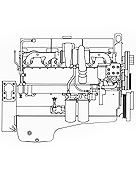CUMMINS ENGINE
- emilio ambasz
- Nov 4, 2023
- 1 min read
Cummins N-14 Diesel Engine (1982)
Cummins X-Series Engine (1987)
The Cummins N-14 diesel engine features a revolutionary oil-cooling technique which extends the engine’s operating period and allows a reduction in engine weight, resulting in enhanced savings for the manufacturer. The N-14 engine, with models ranging from 300 to 450 horsepower, achieves major improvements in fuel economy, noise reduction, durability, and emissions while retaining enough commonality with current N-type engines to permit use of much of Cummins existing tooling and transfer lines. The arrangements of the Turbo charger, after-cooler, and cross-over on one side of the engine has resulted in a height reduction of nine inches allowing it to fit a greater range of vehicles. The cylinder block and valve covers express power and denote structural strength. The dark blue and black color scheme emphasizes ruggedness.
Cummins X-Series Engine
The five mid-range diesel engines comprising the series range from four-to nine-liters, and were developed for automotive, industrial, and marine use. The modular nature of the engine systems and component integration coupled with a commonality of parts results in improved quality-control, cost-efficiency, a reduced parts inventory, and shorter maintenance training time. The clean, uncluttered aesthetic suggests the engine’s power and strength. Charcoal gray emphasizes its ruggedness and unique design qualities. A specially-mixed dark blue and black color scheme, complemented with red accents, sets the top-end model apart from the rest of the family. Production is streamlined by producing the engine’s fully-integrated electronic monitoring and guidance systems on an advanced variable production line.








